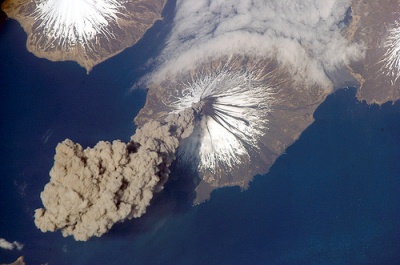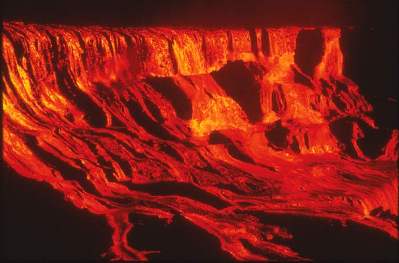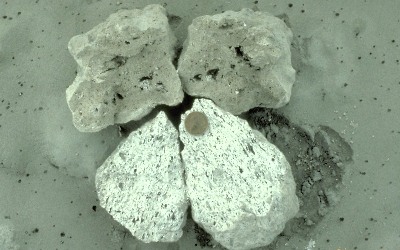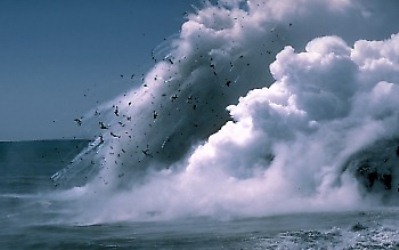
Dramatic to view, volcanos pose danger
Volcanoes are nature’s most dramatic and violent phenomena, but these breathtaking landscapes also present visitors to our national parks with some of nature’s most dangerous hazards.
Lava flows, wildfires, landslides, volcanic ash, sudden explosions, and poisonous gases are just some of the hazards volcanoes present. Each day, park rangers and United States Geological Survey (USGS) scientists monitor park conditions in an effort to protect park visitors.
The USGS monitors more than 160 volcanoes in the U.S., most of which are found within the Cascades Mountain Range along the West Coast and the Aleutian Range in Alaska. The nation’s most active and dangerous, however, can be found in Hawaii.
| Click on the video at right to view an audio slideshow about volcano dangers and safety in national parks narrated and prepared by writer Jon Sheairs. Images courtesy of the National Park Service and U.S. Geological Survey. |
Hawai’i Volcanoes National Park, located on the “Big Island” of Hawai’i, is home to Kilauea, the volcano the USGS considers the most dangerous in America. Kilauea has been erupting continuously since 1983, and consequently it presents major health hazards for visitors to the park.
Lava flows incinerate everything in their path, typically burning at 950 to 1200 degrees Celsius, but they move at speeds around three kilometers per hour and pose more of a threat to property than humans.
It’s when the lava meets the sea that the sparks start to fly.
“When lava meets the sea it’s called a fuel-coolant interaction, said Charlie Mendeville, USGS associate program coordinator for Volcano Hazards. “The heat causes the water to flash boil, generating tremendous explosions that can hurl debris hundreds of meters.”
Besides these explosions, known as tephra jets, lava entering the sea can also cause landslides in which the new land formed by the flow breaks off into the sea. These can be particularly dangerous and, on April 19, 1993, a man was swept into the ocean by one of these landslides.
 |
Cleveland Volcano in Alaska’s Aleutian Islands erupts on May 23, 2006, sending a plume of volcanic ash 20,000 feet into the atmosphere. Cleveland is one of the most active volcanoes in the area (Photos courtesy of the National Park Service and U.S. Geological Survey). |
Lava isn’t the only hazard, however. Volcanoes also emit poisonous sulfur dioxide gas, which irritates skin and mucous membranes in the eyes, ears and throat, and can cause respiratory distress. Since 1986 sulfur dioxide levels in the air on Hawai’i have exceeded Federal Health Standards more than 85 times.
“Beyond sulfur dioxide, volcanoes also emit carbon dioxide, which acts as an asphyxiate, and hydrogen sulfide which can cause paralysis, coma and even death during concentrated, prolonged exposure,” Mendeville explained. “Unlike sulfur dioxide, these gases are odorless, making them particularly hazardous.”
While the hazards from lava, or “red,” eruption are severe, “black” eruptions, or those in which volcanic ash is hurled into the air, present entirely different threats to visitor safety.
Volcanic ash, sometimes known as pumice, is not something you’ll find in any fireplace.
| At left and below, Kilauea in Hawaii Volcanoes National Park erupts in 1983, spewing lava from its crater. This marked the beginning of an eruption that continues today and is America’s most active volcano. Next below, a massive lava flow spills over a cliff while making its way down the volcano. |  |
“Volcanic ash is volcanic rock loaded with flinched glass bone,” Mendeville added. “When the pieces are larger than two millimeters in diameter they’re called pumice.”
This ash creates problems not only for humans, but it also has devastating effects on machinery, and in particular airplanes.
“Breathing in ash can exacerbate respiratory problems, and irritate the upper respiratory system,” said Mendeville. “Commercial planes move at 300 to 400 miles per hour. This creates a volcanic sandstorm that abrades cockpit windows, disrupting vision, and can render key flight instruments, such as altimeters and airspeed indicators unusable. Ash actually plates out on the turbines, causing engine failure.”
 Yellowstone National Park has been the site of some of the largest “black” eruptions in history, thanks to its location over the largest volcanic system in the U.S.
Yellowstone National Park has been the site of some of the largest “black” eruptions in history, thanks to its location over the largest volcanic system in the U.S.
The Yellowstone Caldera, as the volcano is known, hasn’t has a full-scale eruption in more than 640,000 years, but that doesn’t mean there aren’t dangers present.
“The magma underneath the surface is constantly moving,” said Al Nash, chief of affairs at Yellowstone. ”This fuels our park’s world-famous geothermal activity, but also present risks such as hydrothermal vent explosions and earthquakes.”
With such high risks involved, the USGS makes sure to keep a close eye on all of America’s volcanoes.
“The USGS monitors 169 volcanoes in the U.S.,” said Clarice Ransom, USGS spokeswoman for natural hazards. Using the National Volcano Early Warning System the USGS provides monthly assessments of each volcano’s status, ranking the most dangerous. Monitoring is done at five volcano observatories located throughout the nation.”
The USGS Volcano Hazards Program is the entity responsible for monitoring and assessing volcanoes, as well as responding to volcanic crises and conducting research. The program, along with the Volcano Disaster Assistance Program, ultimately seeks to advance the scientific understanding of volcanism, as well as mitigate its harmful impacts on society.
The USGS monitors volcanoes using a variety of techniques.
 |
Large pieces of volcanic ash called pumice are one of the most dangerous volcanic hazards. Pumice can down an airplane and create respiratory issues if inhaled. |
“Using satellite infrared imagery we can assess what gases a volcano is emitting and, using radar, we can track the plume of an eruption” said Mendeville. “We can also detect the volcano swelling before an eruption using GPS instruments that can detect just a few millimeters of deformation.”
USGS scientists also test the acidity of local ground water, and use tilt meters to detect changes in the volcano’s slope. Seismometers also provide valuable information.
“By recording seismic activity, we can detect where earthquakes are causing breakages in the ground, which can help us determine when and where magma will breach the surface,” Mendeville said.
By monitoring volcanoes for these tell-tale signs of an impending eruption, the USGS seeks to minimize potential casualties of volcanism, but ultimately each park visitor must arm themselves with the ultimate weapon: knowledge.
“Volcanoes pose a great threat to public travel and air quality,” Ransom added. “People who visit them must protect themselves with knowledge of the risks.”
Officials at Hawai’i Volcanoes express similar sentiments.
“In a typical year we’ll files about 500 incident reports dealing with visitor injuries in the park,” said Cindy Orlando, superintendent of Hawai’i Volcanoes National Park. “About half occur at the Eruption Site, but the rest are usually due to a lack of preparedness on the visitor’s part. Entering the park with insufficient clothing and footwear or without drinking water and a flashlight greatly increases your level of risk.”
“Knowledge is paramount,” said Mendeville. “Always check with park rangers to check what areas are closed off. Knowledge is your asset.”
| A Kilauea lava flow makes contact with the ocean, creating a massive tephra jet that propels debris high into the air. |  |
Indeed, if it’s information you’re looking for, the USGS provides all you’ll ever need.
Updates to the National Volcano Early Warning System are made every day, and in times of an eruption updates are posted continuously as developments occur. The USGS also provided extensive in-depth information on its website regarding volcanoes and their hazards so guests aren’t taken by surprise.
Ultimately, guests visiting a national park with volcanoes must take it upon themselves to do the necessary research and stay up to date with USGS and park service status updates. Viewing volcanoes up close may carry risks, but by doing the necessary research visitors can view some of nature’s most spectacular processes while minimizing their risk of harm.

Comments are Closed